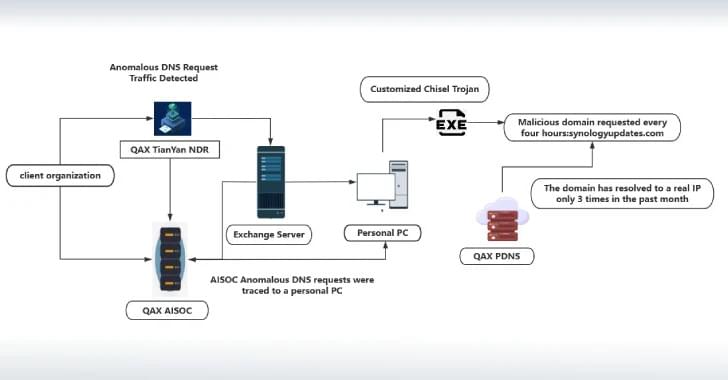One expert, who described the communication technology as “telepathy,” said it could potentially make People’s Liberation Army combat units invisible in electronic warfare, Stephen…



Lithium, the lightest metal on the periodic table, plays a pivotal role in modern life. Its low weight and high energy density make it ideal for electric vehicles, cellphones, laptops and military technologies where every ounce counts. As demand for lithium skyrockets, concerns about supply and reliability are growing.
To help meet surging demand and possible supply chain problems, scientists at the U.S. Department of Energy’s (DOE) Argonne National Laboratory have developed an innovative membrane technology that efficiently extracts lithium from water. Several team members also hold joint appointments with the Pritzker School of Molecular Engineering (PME) at the University of Chicago.
The findings appear in the journal Advanced Materials.

The laser weapon can kill mosquitoes, and it also has a detection system which makes it safe for humans and pets.

Cybersecurity researchers have shed light on a previously undocumented threat actor called NightEagle (aka APT-Q-95) that has been observed targeting Microsoft Exchange servers as a part of a zero-day exploit chain designed to target government, defense, and technology sectors in China.
According to QiAnXin’s RedDrip Team, the threat actor has been active since 2023 and has switched network infrastructure at an extremely fast rate. The findings were presented at CYDES 2025, the third edition of Malaysia’s National Cyber Defence & Security Exhibition and Conference held between July 1 and 3, 2025.

Spector originally pitched the project under the working title Troubleshooter at his former studio, Origin Systems. He wanted to create something truly new, saying he was tired of space marines, aliens, and wizards in hats.
The main character of Troubleshooter was meant to be Jake Shooter, a super-cop called in by secret agencies for high-risk missions.
“Deus Ex was part shooter, part stealth game, part RPG. I mean, how do you sell that? The argument I got from the Thief folks was that if you give players a gun, they won’t sneak. I was also asked, ‘Why don’t you just make a shooter?’ I learned the power of the word ‘no’ when pitching Deus Ex, let me tell you,” said Spector.
Marine scientists have long marveled at how animals like fish and seals swim so efficiently despite having different shapes. Their bodies are optimized for efficient aquatic navigation (or hydrodynamics), so they can exert minimal energy when traveling long distances.
Autonomous vehicles can drift through the ocean in a similar way, collecting data about vast underwater environments. However, the shapes of these gliding machines are less diverse than what we find in marine life—the go-to designs often resemble tubes or torpedoes, since they’re fairly hydrodynamic. Plus, testing new builds requires lots of real-world trial-and-error.
Researchers from MIT’s Computer Science and Artificial Intelligence Laboratory (CSAIL) and the University of Wisconsin-Madison propose that AI could help us explore uncharted glider designs more conveniently. The research is published on the arXiv preprint server.

Hans Albrecht Bethe was born in Strasbourg, Alsace-Lorraine, on July 2 1906. He attended the Gymnasium in Frankfurt from 1915 to 1924. He then studied at the University of Frankfurt for two years, and at Munich for two and one half years, taking his Ph. D. in theoretical physics with Professor Arnold Sommerfeld in July 1928.
He then was an Instructor in physics at Frankfurt and at Stuttgart for one semester each. From fall 1929 to fall 1933 his headquarters were the University of Munich where he became Privatdozent in May 1930. During this time he had a travel fellowship of the International Education Board to go to Cambridge, England, in the fall of 1930, and to Rome in the spring terms of 1931 and 1932. In the winter semester of 1932–1933,he held a position as Acting Assistant Professor at the University of Tubingen which he lost due to the advent of the Nazi regime in Germany.
Bethe emigrated to England in October 1933 where he held a temporary position as Lecturer at the University of Manchester for the year 1933–1934, and a fellowship at the University of Bristol in the fall of 1934. In February 1935 he was appointed Assistant Professor at Cornell University, Ithaca, N. Y. U.S.A., then promoted to Professor in the summer of 1937. He has stayed there ever since, except for sabbatical leaves and for an absence during World War II. His war work took him first to the Radiation Laboratory at the Massachusetts Institute of Technology, working on microwave radar, and then to the Los Alamos Scientific Laboratory which was engaged in assembling the first atomic bomb. He returned to Los Alamos for half a year in 1952. Two of his sabbatical leaves were spent at Columbia University, one at the University of Cambridge, and one at CERN and Copenhagen.

In-space manufacturing is a relatively new field that seeks to utilize the unique characteristics of outer space and/or low-Earth orbit to achieve fabrication methods not possible on Earth. Space Forge’s primary goals are to produce semiconductors for data center, quantum, and military use cases, using “space-derived crystal seeds” to initiate semiconductor growth, utilizing unlimited vacuum and subzero temperatures for manufacturing, and then returning the chips to Earth for packaging.
The ForgeStar-1 satellite will not bring the cargo it manufactures back to Earth at the completion of its mission. Acting more as a proof-of-concept and prototype for a litany of technologies engineered by Space Forge, the satellite will be tasked with running through the successful application of key technologies for in-space manufacturing, and will end its mission with a spectacular fireball.
Space Forge plans to test both the best-case and worst-case scenarios for the satellite’s recovery. First, it will deploy its proprietary Pridwen heat shield and on-orbit controls to steer the satellite, and then test its failsafe mechanism, which involves disintegrating the craft in orbit.

The threat actor behind the GIFTEDCROOK malware has made significant updates to turn the malicious program from a basic browser data stealer to a potent intelligence-gathering tool.
“Recent campaigns in June 2025 demonstrate GIFTEDCROOK’s enhanced ability to exfiltrate a broad range of sensitive documents from the devices of targeted individuals, including potentially proprietary files and browser secrets,” Arctic Wolf Labs said in a report published this week.
“This shift in functionality, combined with the content of its phishing lures, […] suggests a strategic focus on intelligence gathering from Ukrainian governmental and military entities.”